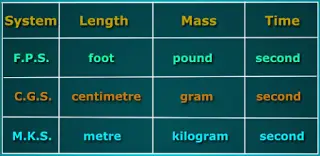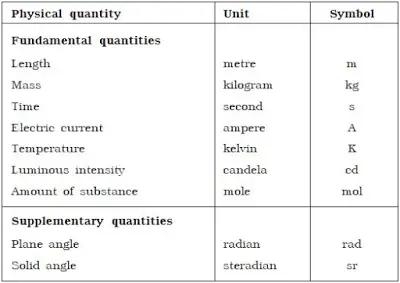Unit
The result of measurement of a physical quantity must be defined both in kind and magnitude. The standard measure of each kind of physical quantity is called a unit.
Lets take an example of length.
As we know that length is a physical quantity. The metre is a unit of length that represents a definite predetermined length. When we say 20 metres (or 20 m), we actually mean 20 times the definite predetermined length called “metre”.
Types of physical Quantities
Contents
show
We can broadly divide the physical quantities in to two types
- Fundamental Physical quantities
- Derived Physical quantities
1. Fundamental physical quantities
A physical quantity which can exist independently is called as Fundamental physical quantity.
Example: Mass, Length, and time, etc.
2. Derived physical quantities
A physical quantity which can not exist independently is called as Derived physical quantity.
OR
Derived physical quantity is a physical quantity which is dependent or derived from any other physical quantity.
Example: Volume, Area, density, acceleration, speed, force, energy, etc.
Types of Units
- Fundamental units
- Derived units
1. Fundamental units
The units which are independent or can not derived from any other unit is called fundamental unit.
OR
The units of fundamental physical quantities are called fundamental units.
Example: (a) Every unit of time is a fundamental unit (irrespective of the system to which it belongs). microsecond, millisecond, second, minute, hour, day etc are units of time. All these units are fundamental units.
(b) Every unit of length is fundamental unit. Millimeter, centimeter, meter, kilometer etc. are units of length. All these units are fundamental units.
2. Derived units
The units of derived physical quantities are called derived units. Units of volume, area, speed, density, energy, etc are derived units.
Example: (a) Every unit of acceleration is a derived unit; m/sec², cm/sec², km/hr², etc.
(b) Every unit of density is a derived unit; kg/m³, gm/cm³, etc.
(c) Every unit of speed is a derived unit ; m/sec, cm/sec, km/hr, etc.
System of Units
There are four systems of units to measure the fundamental physical quantities.
- C.G.S system (metric system)
- F.P.S system (British system)
- M.K.S system
- S.I system (System International)
In the first three systems namely, C.G.S system, F.P.S system, M.K.S system, only 3 physical quantities length, mass, and time are considered to be fundamental quantities. So there are 3 units corresponding to 3 fundamental physical quantities in the above three systems.
But, in S.I system (System International), there are 7 fundamental physical quantities namely Mass, Length, Time, Electric current, Thermodynamic temperature, Luminous intensity, Amount of substance. So there are 7 units corresponding to 7 fundamental physical quantities in S.I system.
There are two more supplementary physical quantities namely Plane angle and Solid angle. Hence 2 supplementary units corresponding to two supplementary physical quantities.
Dimension
A dimension is a measure of a physical quantity (without numerical values).
Difference between Unit and Dimension
A dimension is defined as a measure of a physical variable (without numerical value), while a unit is a way to assign a number or measurement to that dimension. Example, mass is a dimension, but it is measured in units of kilogram (Kg).
Standards
A standard is a physical representation of a unit of measurement. It is applied to a piece of equipment having a known measure of physical quantity. Now this know value is used for the purpose of obtaining the values of the physical properties of other equipment.
Standard Classifications
Measurement standards are classified in four types as:
- International standards
- Primary standards
- Secondary standards
- Working standards
1. International standards
These standards are defined by international agreements, and are maintained at the International Bureau of Weights and Measures in France. These are as accurate as it is scientifically possible to achieve. These standards are not available to the ordinary user of measuring instruments for the purposes of calibration or comparison.
2. Primary standards
Primary standards are maintained at institutions in various countries around the world. They are also constructed for the greatest possible accuracy. The main function of Primary standard is to check the accuracy of secondary standards.
3. Secondary standards
Secondary standards are employed in industrial measurement laboratories as references for calibrating high accuracy equipment and components. It is used to verify the accuracy of working standards. Secondary standards are periodically sent to the national standard laboratories that maintain primary standards for calibration and comparison.
4. Working Standards
Working standards are used to check and calibrate the general laboratory instruments for their performance and accuracy.
Excercise
Q 1. Define physical quantities.
Answer. All the quantities in terms of which laws of physics can be described and which can be measured are known as physical quantities.
Q. What are the types of Physical quantities?
Answer. There are two types of physical quantities
1. Fundamental quantities: Those physical quantities which do not depend upon any other quantity are known as fundamental quantities or base quantities. There are seven fundamental or base quantities in SI system. They are Length, Mass, Time, Electric current, Thermodynamic temperature, Amount of substance and Luminous intensity.
2. Derived quantities: Those physical quantities which are derived from the fundamental quantities are known as derived quantities.
Q 2. What is the difference between fundamental and derived units?
Q 3. Distinguish between absolute, primary and auxiliary fundamental and derived units.
Q 4. What do you understand by the dimension of a quantity?
Q 5. What are the basic units in SI system?
Q. What is the difference between primary and secondary standards?
Q. How the accuracy of the secondary standards is ensured?


